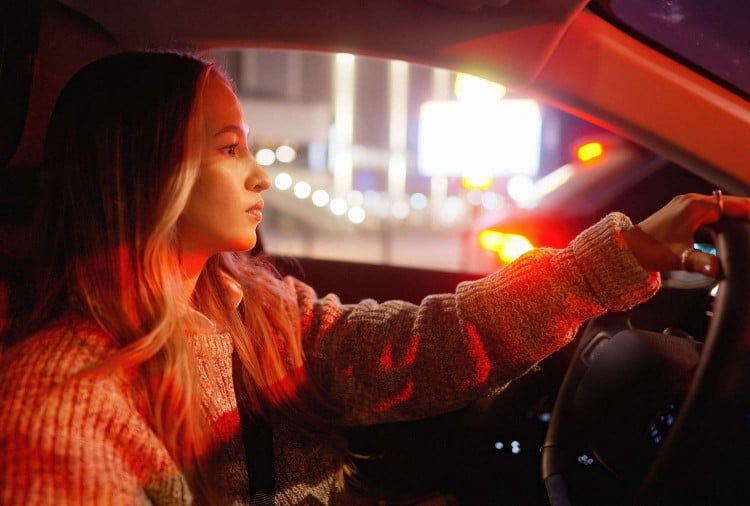- Holiday lights, like those people decorate their homes with for Christmas, may negatively impact people with astigmatism and their ability to see clearly while driving.
- This is largely due to increased glare; this can be further worsened by wet roads that lights may reflect on, too.
- Experts recommend following proper safety protocol, like maintaining an updated eyewear prescription and avoiding driving in situations where you feel your vision may be an obstacle.
The holiday season may pose a unique obstacle for people with astigmatism.
Nothing puts you in the holiday spirit like seeing a myriad of lights and decorations. However, there is one thing that can put a damper on your holiday cheer: driving at night with astigmatism.
Astigmatism occurs when there is an imperfection in the curvature of the eye, resulting in blurry vision. The condition is a type of refractive error—150 million Americans have a refractive error.
“Holiday lights can negatively impact people with astigmatism due to the way light is refracted in their eyes,” said James Kelly, MD, an ophthalmologist based in NYC and Long Island.
“I define astigmatism as a common eye condition where the cornea or lens is irregularly shaped, causing light rays to refract unevenly and leading to blurred or distorted vision,” he said.
Holiday lights may appear blurred or have an elongated starburst for astigmatic patients, Jennifer L. Stone, OD, an optometrist based in Baltimore, told Health.
“This glare may interfere with the crisp details of their vision and can impact distant and near objects,” she said.
It’s important to understand that there are different levels of astigmatism, and as a common health condition, there are many people who experience little to no symptoms.
“Uncorrected astigmatism might cause additional glare with any lights, holiday lights being no different,” said Timothy McCulley, MD, professor and chair of ophthalmology with UTHealth Houston. “Generally, this is not to a degree that it is impactful.”
Here’s how holiday lights may increase risks for people with astigmatism, as well as tips for driving safely this holiday season.

LUZA STUDIOS /Getty Images
How Holiday Lights May Increase Risks For People With Astigmatism
With the additional lights this time of year, people with astigmatism may face more health concerns.
Kelly explained that increased glare is the first concern.
Since there are so many flashy and bright holiday lights, increased glare in the eye is common. For someone with astigmatism, this glare can be more pronounced and distracting, potentially impairing their ability to see the road.
Kelly explained that astigmatism is already known for “dizzying” or “shaky” vision in more severe cases. When the holiday lights have a moving or flashing component, they can be even more unsettling for the eye and could lead to accidents or distractions on the road.
Additionally, halos and starbursts around lights can make it difficult to differentiate between different lights like traffic lights, street lamps, and decorative lights.
The contrast amongst lights (like bright holiday colors) can also make it harder to see important traffic light signs. This can be worsened by wet roads that create reflections—these reflections can distort vision and increase glare.
“To lessen these risks, those with astigmatism should make sure that they have the correct prescription for their glasses or contact lenses, consider anti-reflective coatings on their eyewear, and be extra careful when driving at night in areas with heavy holiday decorations,” Kelly advised.
All of the additional visual challenges from holiday lights can lead to a quicker onset of eye strain and fatigue for drivers with astigmatism, potentially affecting their concentration and reactions behind the wheel.
“If the visual disturbances are significant, it may be safer to avoid driving at night in these conditions or to take alternate routes when driving that may avoid the decor,” Kelly said.
8 Common Causes of Blurry Vision
Safely Driving in the Dark With Astigmatism
People with vision issues or concerns, particularly when driving in the dark with the addition of extra lights, should be aware of certain safety tips.
Kelly recommends patients with astigmatism prioritize the following:
Understand Your Vision Limitations
People with vision conditions should be aware of how their specific vision issues affect their night driving. Conditions like astigmatism, myopia (nearsightedness), presbyopia (age-related farsightedness), and cataracts can all impact your ability to see clearly in low-light conditions.
Schedule Regular Eye Exams
Kelly emphasized that regular check-ups with an eye care professional are crucial. This is to get up-to-date prescriptions and receive personable advice on the best practices for night driving.
Prioritize Appropriate Eyewear
Making sure your eyewear is updated is crucial for safety, whether or not you have astigmatism.
“If eyeglasses have been prescribed, make sure they are in good condition and wear them in situations of high glare,” Stone stated.
Beyond just glasses, if you are wearing wear contact lenses, it’s important to make sure they aren’t causing you dry eye, or that you manage the dry eye with the right drops. Using the wrong treatment can worsen your eyesight as well.
Adjust Your Driving Habits
With the understanding that holiday lights can worsen driving environments, it’s important to remain aware of the decreased visibility and prioritize increased reaction times. Increase the distance between your car and the one in front of you to ensure you have ample time to react.
Reduce Driving Distractions
In addition to adjusting your driving habits, you should minimize internal distractions in your car like bright dashboard lights, screens, and loud music. Stone recommends people turn down the console brightness, as well as extra devices and interior lights.
This helps you focus more on the road and the environment around you.
Clean Windshield and Headlights Regularly
Ensuring your windshield, windows, and headlights are clean can go a long way in staying safe while driving, too. Dirt or grime can exacerbate glare and reduce visibility.
“Ensure that your windshield is clean, inside and out to reduce grimy reflections and eliminate extra sources of glare from within the vehicle,” Stone said.
Give Your Eyes Breaks
If you’re feeling eye strain or fatigue, it is important to take a break. Driving with tired or strained eyes can significantly impair your ability to react quickly.
Know When You Shouldn't Drive
If you feel that your vision significantly impairs your ability to drive safely at night, especially with the added distraction of holiday lights, it might be best to avoid driving under these conditions.
Also, keep in mind that “the average astigmatism is not apt to cause much glare. If glare is an issue, it’s more likely to be cataracts,” said McCulley. “If you don’t feel safe driving, it’s best not to.”
Do Blue Light Glasses Really Work? New Research Shows Little Benefit for Eye Health
Related pages
ADHD: Children often use healthcare services before diagnosis
Share on PinterestResearchers say healthcare professionals need to be more aware of ADHD symptoms in

What Is a Scooped Bagel—And Is It Really Healthier?
A scooped bagel is a bagel with the interior partially scooped out, potentially making more room for

The Order You Eat Your Food In May Impact Blood Sugar Levels
Food sequencing refers to the order in which different foods are consumed during a meal.Some experts

Cantaloupe Recalled Due to Salmonella Contamination
Nearly 6,500 cases of whole cantaloupe, from the brand Kandy, have been voluntarily recalled, accord

How Hobbies Can Contribute to Cognitive Health
Having a hobby can help boost your cognitive health.Specifically, hobbies that utilizes hand-eye coo

COVID Might Help Trigger New-Onset High Blood Pressure
COVID might increase the risk of developing high blood pressure more than influenza, a new study has

